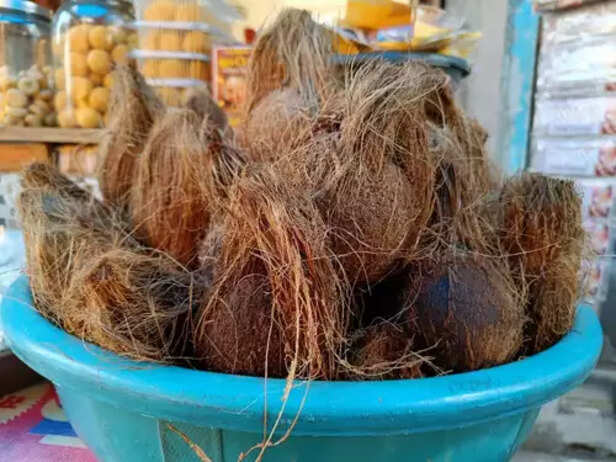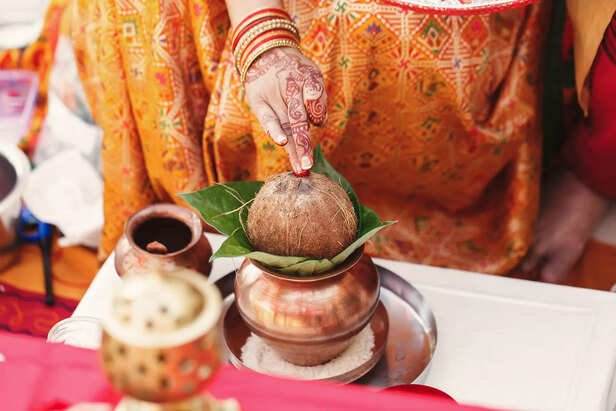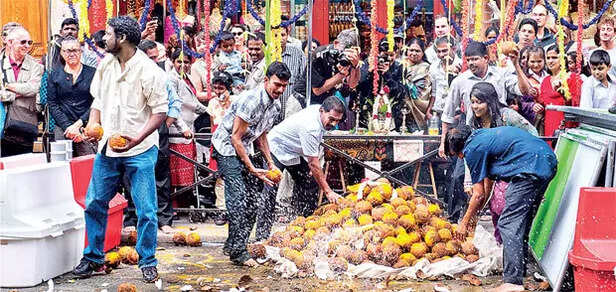Why Do hindu Break Coconuts in Temples Before Puja? The Ancient Ritual With a Powerful Hidden Meaning
Mitali | Apr 26, 2025, 14:28 IST
Ever questioned why coconuts are smashed in temples as part of Hindu ceremonies? This article delves into the ancient origins, spiritual symbolism, and cultural meaning behind this ritual. From myth to contemporary temple practice, discover the science, stories, and spiritual teachings concealed within coconutbreaking. Essential reading for anyone interested in Hindu tradition and sacred rites!
Have you ever stood outside an Indian temple and seen a devotee smashing a coconut with deep concentration and devotion? It's not theatrics—it's a sacred action deeply embedded in spirituality and culture. Why are coconuts broken in temples? The key is in the rich fabric of Hindu rituals for worshipping deities, purifying the mind, and asking for divine favours.
Coconutbreaking is not just a symbolic gesture. It symbolizes the shattering of the human ego and the presentation of an untainted heart to the divine. This simple yet deep practice has endured for centuries and remains applicable in today's spiritual arena.

The application of coconuts in Hindu worship stretches back to Vedic days. Ancient literature cites fruits as oblations to gods, and the coconut comes to the fore due to its special form and significance. The fruit was a simple crop to cultivate in tropical India and entered the fold of various religious ceremonies. Traditionally, animal sacrifices were practiced in Vedic rituals. But as Ahimsa (non-violence) gained prominence and as the spiritual consciousness evolved, coconuts came to be used as a symbolic offering, free of blood and pure.
Temple authorities made this practice official over time, and now, breaking coconuts is an integral part of Hindu temples, particularly in South India.

The coconut stands out in its structure—and it's no accident. Here's what each element represents:

Hindu mythology abounds with tales that provide meanings for coconuts. There is one well-known story that features Lord Ganesha. Since an ancient sage was unable to make an animal sacrifice, he replaced it with a coconut. Satisfied by this symbolic act, Ganesha accepted it, and this became an example used in subsequent rituals.
In another Skanda Purana story, coconuts are described as being made by Sage Vishwamitra as an offering when the wish-fulfilling tree Kalpavriksha was not present.
So, why do we break the coconut? It's an act of powerful surrender. By breaking the coconut, you're saying to the universe:
"I release my pride, my ego, and my outer self. I give my genuine, humble self to you."
This is in perfect harmony with the philosophy of Bhakti Yoga, where surrender is key to attaining divine union. The ritual also facilitates inner purification, aligning the devotee with higher spiritual vibrations.

Apart from temple rituals, coconut-breaking is a staple in:

Even science has a word on this.

In rural communities, coconuts are not just fruits—they're gifts from god. There is a use for everything: water, shell, fiber, kernel. Nothing goes to waste. This is at the heart of Hindu philosophy. To offer a coconut is to give back a piece of nature with thanksgiving and respect.

The coconut teaches us that:
So why do we crack coconuts in temples? It's not about tradition—it's a strong spiritual symbolism. A reminder that in order to be one with the divine, you must break away from ego and pretenses. Whether you're religious or just interested, this ceremony has ageless wisdom for a humble, enlightened life.
Explore the latest trends and tips in Health & Fitness, Travel, Life Hacks, Fashion & Beauty, and Relationships at Times Life!
Coconutbreaking is not just a symbolic gesture. It symbolizes the shattering of the human ego and the presentation of an untainted heart to the divine. This simple yet deep practice has endured for centuries and remains applicable in today's spiritual arena.
1. Historical Background of Coconut Breaking

coconut.
( Image credit : Times Life Bureau )
The application of coconuts in Hindu worship stretches back to Vedic days. Ancient literature cites fruits as oblations to gods, and the coconut comes to the fore due to its special form and significance. The fruit was a simple crop to cultivate in tropical India and entered the fold of various religious ceremonies. Traditionally, animal sacrifices were practiced in Vedic rituals. But as Ahimsa (non-violence) gained prominence and as the spiritual consciousness evolved, coconuts came to be used as a symbolic offering, free of blood and pure.
Temple authorities made this practice official over time, and now, breaking coconuts is an integral part of Hindu temples, particularly in South India.
2. The Symbolism of the Coconut in Hinduism

broken coconut
( Image credit : Freepik )
The coconut stands out in its structure—and it's no accident. Here's what each element represents:
- Outer Husk (Coir): Represents our rugged outside—the ego and ignorance.
- Hard Shell: Symbolizes the stubbornness of human nature.Inner White Kernel: The spiritual soul or the inner self.
- Coconut Water: Represents our thoughts and emotions.
3. Mythological Stories Behind Coconut Breaking

Ganpati.
( Image credit : Freepik )
Hindu mythology abounds with tales that provide meanings for coconuts. There is one well-known story that features Lord Ganesha. Since an ancient sage was unable to make an animal sacrifice, he replaced it with a coconut. Satisfied by this symbolic act, Ganesha accepted it, and this became an example used in subsequent rituals.
In another Skanda Purana story, coconuts are described as being made by Sage Vishwamitra as an offering when the wish-fulfilling tree Kalpavriksha was not present.
4. Spiritual Significance of the Practice
So, why do we break the coconut? It's an act of powerful surrender. By breaking the coconut, you're saying to the universe:
"I release my pride, my ego, and my outer self. I give my genuine, humble self to you."
This is in perfect harmony with the philosophy of Bhakti Yoga, where surrender is key to attaining divine union. The ritual also facilitates inner purification, aligning the devotee with higher spiritual vibrations.
5. Coconut in Other Indian Rituals

coconut-mango-leaves-put-bronze
( Image credit : Freepik )
Apart from temple rituals, coconut-breaking is a staple in:
- Weddings: Blessing the couple and keeping evil at bay.
- Housewarming (Griha Pravesh): Providing divine protection.
- Vehicle Puja: Calling for safe journeys.
- Navagraha Puja: Appeasing planetary gods.
6. Science's Take on Coconut Breaking

Half coconut.
( Image credit : Times Life Bureau )
Even science has a word on this.
- Breaking forcibly is an energy release form, said to give out good vibrations.
- Sound and action offer psychological gratification, akin to a mini catharsis.
- Rituals, particularly those involving repetition, soothe the mind and allow for the space of being present.
7. Relationship with Nature and Farming

coconut-farm.
( Image credit : Freepik )
In rural communities, coconuts are not just fruits—they're gifts from god. There is a use for everything: water, shell, fiber, kernel. Nothing goes to waste. This is at the heart of Hindu philosophy. To offer a coconut is to give back a piece of nature with thanksgiving and respect.
8. Life Lessons from the Ritual in Today's Times

coconut breaking temple
( Image credit : Freepik )
The coconut teaches us that:
- Ego needs to be broken to see inner beauty.
- Strength lies in humility.Inner purity is what matters, not externals.
9. A powerful spiritual metaphor.
Explore the latest trends and tips in Health & Fitness, Travel, Life Hacks, Fashion & Beauty, and Relationships at Times Life!
